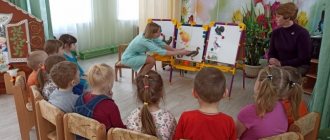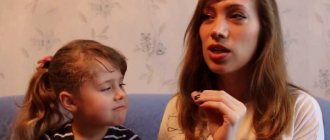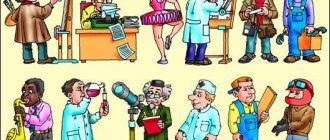Summary of an individual speech therapy lesson on the topic: “Producing sound [L]”
Goal: formation of the correct pronunciation of the sound [l] in an isolated position.
Tasks:
- Development of phonemic awareness and phonemic analysis;
- Development of articulatory motor skills, VMF.
- Cultivating perseverance.
Technologies used:
- Health-saving technologies;
- Developmental technologies.
Plan:
I. Organizational moment; II. Subject message; III. Articulation gymnastics; IV. Sound setting [l]; V. Clarification of the articulation of sound [l]; VI. Development of phonemic analysis; VII. Strengthening the connection between the letter and the sound [l]; VIII. Summing up the lesson.
Progress of the lesson
I. Organizational moment
There are several pictures in front of the child (onions, carrots, cabbage). The speech therapist reads the riddle: The grandfather is sitting, dressed in a hundred fur coats, Whoever undresses him sheds tears. - What kind of vegetable is this? Show it in the picture. The child finds a picture of an onion. L.: Yes, this is an onion. What is the first sound in the word onion? R.: Sound [l]. L.: That's how the ship hums. Let's sound the horn and show the ship: the fingers of the hands extended forward are closed at an acute angle, depicting the stern of the ship.
II. Lesson topic message
Today we will learn to hear, find in words and pronounce the sound [l].
III. Development of phonemic processes
L.: I will pronounce the words, and when you hear a word with the sound [l], clap your hands. The speech therapist pronounces the words: lamp, board, cat, bow, shelf. The child claps when he hears the sound [l] in a word. L.: Look at the pictures (the speech therapist names the pictures). Find only those that have the sound [l]. Lamp, squirrel, table, wardrobe, pencil, desk. The child selects the necessary pictures. L.: Let's play the game “Fourth Extra.” The extra words will be those whose names do not have the sound [l]. Spoon, cat, skis, horse; lamp, shelf, board, shovel. The speech therapist pronounces the words and places four pictures in front of the child, the child finds and removes the extra picture. L.: Do you want to ride the train? In front of you is a train with three carriages and pictures (The speech therapist offers the child pictures depicting words with the sound [l] at the beginning, middle and end of the word). Place the words on the cars. If the sound is at the beginning - in the first car, if in the middle - in the middle car (second), if at the end - in the third.
IV. Articulation gymnastics
The exercises “Painter”, “Horse”, “Needle”, “Strongman” are performed.
V. Clarification of sound articulation [l]
L.: Look at the tongue when it pronounces the sound [l]. (The speech therapist shows a picture of the sound profile). Where is the tip of the tongue? R.: tip of tongue at the top. Are your teeth closed or open? R.: Revealed. Are the lateral edges of the tongue pressed against the upper teeth or not? R.: No L.: The tongue is saddle-shaped. (The speech therapist shows a picture with a saddle, the child repeats; you can show a dummy tongue).
VI. Sound setting [l]
The speech therapist uses three methods of setting. 1. (By imitation) L.: Sound like a ship (l-l-l-l-l) 2. (Based on the profile of the tongue and verbal instructions in front of the mirror) L.: Make a needle. Look how sharp the tip of the tongue is. Lift it up and press it against the tubercles (alveoli) (the speech therapist shows the profile). Now sound like a steamboat (make the sound [s]). Do not lower the tip of the tongue. 3. (From the interdental sound [s]) L.: Make a wide tongue, insert it between the teeth, lightly bite the tip of the tongue and pronounce the sound [s] for a long time - you get a hard sound [l]. After the performance, the speech therapist suggests honking like a steamship, then like an airplane, like an elephant.
VII. Summing up the lesson
- What sound did we learn to pronounce? - Sound [l]. — How to pronounce the sound [l]? (The child repeats the articulation of the sound l).
Teacher-speech therapist MBDOU DS combined type No. 3, Smolensk: Rubtsova Maria Aleksandrovna
Also on topic:
Summary of an individual lesson on sound consolidation [L]
Article:
Goal: to develop the skill of pronouncing the sound [L] in forward and backward syllables and words.
Tasks:
Correctional and educational:
- automate the sound [L] in syllables, words, sentences.
Correctional and educational:
- develop interest in activities
- the ability to control your speech.
Correctional and developmental:
- development of motor skills of the speech apparatus
- fixing the correct pronunciation of a given sound in syllables, words, sentences
- development of visual-spatial functions.
Equipment: mirror, pictures, map, diagram for sound analysis.
Progress of the lesson
1. Organizational moment.
Speech therapist: Hello! I am very glad to see you! How are you doing? How are you?
Sit comfortably, don’t forget to keep your back straight. Let's remember where each of our classes begins?! That's right, from charging. Look in the mirror and go through the motions.
2. Articulation gymnastics
Speech therapist: To speak correctly and beautifully, you need to do gymnastics for the tongue, lips and cheeks.
- "Smile-Proboscis"
- “Spatula” - “Needle”
- "Swing"
- "The steamer is humming"
- "Delicious jam"
3. Breathing exercises
Speech therapist: Look, I have this bee, let’s blow and see how it flaps its wings while flying.
Instructions: (Inhale through your nose, exhale through your mouth through your lips into a tube, do not raise your shoulders, do not puff out your cheeks)
4. Introduction to the lesson
Speech therapist: Today we have a guest in class. Listen to the riddle and try to guess who it is?
She buzzes over the flower, flies quickly towards the hive, gives her honey to the honeycomb; What is her name?! (Bee)
Speech therapist: Correct! This is a cheerful and kind bee, and her name is Lolo. She got a little lost and really wants to return to her home in her fairyland, Beeland. And she got lost because she was looking for someone who could help her remember how to pronounce the sound L.
Let's help Lolo return home and remember how to pronounce the L sound.
5. Analysis of articulation of sounds. Characteristics of sound.
Speech therapist: Tell Lolo how to correctly pronounce the sound [L].
Child: When pronouncing the sound [L], the lips are in a smile, the teeth are open, the tip of the tongue is pressed against the tubercle behind the upper teeth.
Speech therapist: Is the [L] sound consonant or vowel?
Child: Agreeable
Speech therapist: Why?
Child: The sound [L] is consonant, because there is an obstruction in the mouth.
Speech therapist: Voiced or deaf?
Child: Voiced.
Speech therapist: Why is he loud?
Child: When pronouncing the sound [L], the neck trembles.
Speech therapist: Hard or soft?
Child: Solid
Speech therapist: Well, now let's go! We have a map with which we will help Lolo get to her country. This card is unusual, you need to move the index finger of your right hand and pronounce the sound [L].
6. Automation of the sound [L] in syllables.
Speech therapist: So we got to the first point. We are greeted by a singer bee, she loves to fly on the lawn and sing songs. And she wants you to sing with her too.
la-la-la ala-ala-ala lu-lu-lu ulu-ulu-ulu ly-ly-ly yly-yly-yly lo-lo-lo olo-olo-olo
Speech therapist: Let's move on.
7. Automation of the sound [L] in words.
Speech therapist: And now we’ve reached the second point, and this bee invites you to learn how to write poetry. Think of a word that rhymes and repeat the entire poem. Don’t forget to pronounce [L] clearly and correctly.
La-la-la, delicious honey brings... Child: (bee). Lu-lu-lu, we saw... Child: (a bee).
Ly-ly-ly, we were scared... Child: (bees).
Speech therapist: And the bee also wants us to solve the puzzle. Look carefully at the cards. What is shown here. What else do you see? Right! Syllable. What word will you get if you combine a syllable with a word?
8. "Rebus"
Boo (shop) What's the word?
Ku (lak) What is the word?
Cab (onion) What is the word?
9. Physical exercise.
Speech therapist: The bee is a little tired. Let's relax with her.
Here's the bee's exercise. Do it in order. Quickly stand up and smile. Reach higher, reach higher.
Come on, straighten your shoulders, raise them and lower them. Turn left, right, touch your hands with your knees.
Speech therapist: Let's go further, to the third point.
10. Automation of sound in words.
Game “Where the sound was hidden” .
Speech therapist: This bee brought a beautiful box. Look what's in it. Yes, there are a lot of pictures here, in the name of which each object the sound [L] is hidden. Determine the place of the sound in words: at the beginning, in the middle or at the end of the word.
(Baps, horse, bicycle, donkey, football, swallow, saw, hammer, wolf, stick, chalk, flippers, bun, violet, table, hanger, bow, boat).
11. Automation of sound in sentences.
Speech therapist: Here we are almost at the country of the bee Lolo, the last point left. Here we are met by a bee who wants to make us laugh with funny suggestions. Let's listen to them and put them together correctly.
Speech therapist: Mila ate salad.
Child: Mila ate salad.
Speech therapist: Paul fell into a chair.
Child: The chair fell on the floor.
Speech therapist: Half the onion Mila.
Child: Mila, half the onion.
Child: Hurray! So we reached the country of Beeland! And they helped Lolo remember the sound L.
12. Summary of the lesson.
Speech therapist: What sound did we repeat today?
Child: Today in class we repeated the sound [L].
Speech therapist: How to pronounce it correctly?
Child: When pronouncing the sound [L], the lips are in a smile, the teeth are open, the tip of the tongue is pressed against the tubercle behind the upper teeth.
Speech therapist: What is he like?
Child: The sound [L] is consonant, hard, sonorous.
Speech therapist: Our lesson has come to an end. It's time to say goodbye to Lolo. It's time for her to return home.
Exercises to improve speech hearing
To develop speech hearing, speech therapists use the following games:
- “Blizzards, blizzards, what did you sing?”
In this game, children speak words or sentences with different voice levels. Game option – “the wind blows”
- “Speak up! Speak quietly!
The child is shown toys; if they are small, he speaks quietly, if large, he speaks loudly.
- "Guess who's talking!"
You can stage the fairy tale “The Three Bears”, in which the bears speak in different voices (low, high, normal).
The teacher pronounces different sounds, the child must guess where the signal sounds - far or close.
- "Do not miss!"
Adults show the child pictures, which they name with errors. The player must notice the mistake and clap his hands. In the second version of the game, in case of incorrect pronunciation, the baby raises a red circle.
- fox - rice, summer - veto, Luntik - Funtik, rollers - Tolik, oars - adze;
- Fox - yew, kitty, fisa, disa, Lisa.
- “Listen carefully and choose.”
An adult shows a picture and names a series of words, from which you need to choose one:
- bow, hatch, corner, coal;
- sheet - fleece, kitty-kiss.
- "What is this?"
The teacher names a general concept. child is a word containing the sound [L]:
- fruits: oranges, pineapples;
- animals – fox, elk;
- shoes - shoes;
- trees - plum.
To carry out a step-by-step production of the sound [L], systematic training is needed with simple and complex, musical and simple exercises that will teach the child to correct articulation.
Author: Lukina Larisa Mikhailovna
Article design: Vladimir the Great
Reasons for the absence of the correct “L”
Factors that provoke incorrect pronunciation of the sound [L] may include the following:
- improper speech breathing;
- speech hearing problem;
- poor development of the articulatory apparatus, weakness of the tongue muscles;
- individual structure of the frenulum.
Improper speech breathing can be characterized as follows:
- the child has a small lung capacity;
- weakened respiratory muscles (the baby cannot speak loudly);
- exhaled air comes out in jerks or all at once (as a result of which the child cannot pronounce the end of a sentence);
- incorrect, inept distribution of exhaled air (my brother and I are playing... - inhale - heaven);
- hasty pronunciation - choking.
Staging the sound [L] to a child begins in stages with breathing exercises.
The child should be taught to hold the toy: the baby lying on the carpet is asked to inhale - hold his breath (hold the ball) - exhale.
- Setting the correct breath – exhale through the nose and mouth: the preschooler sits, hands are on the stomach. He feels how his stomach inflates (inhale) and how it relaxes (exhale).
- Forming the correct air stream: the child blows snowflakes from his hand, small pieces of paper, balls, a ball, adjusts paper boats, inflates balloons, blows soap bubbles.
- Onomatopoeia exercises that will develop the strength, duration, and focus of breathing:
- it is proposed to sing a vowel sound (o, a, y, y, e), then a consonant [L] is added to it - (la, lo, lu, ly, le);
- imitation of various sounds.
Poor hearing development can be eliminated in the following ways:
- creating an auditory image of sound
Listening to the sounds of mechanisms and natural phenomena will help. It is difficult for a parent to correctly imitate different sounds, so you can open the “Sound of a Fire Truck” website and invite the child to listen to the sound of a motorcycle, train, car, engine, siren, broken glass, rain song, ultrasound. Over time, the child will begin to repeat these sounds.
- repeated pronunciation of words with the sound [L]
le - ice, icebreaker, ice drift; lo: spade, London, burdock; la: swallow, bench, palm; skis: skis, track, pitchforks; lu: puddles, meadows, lawn.
- poor development of the articulatory apparatus,
The speech therapist concludes that the articulation apparatus is weakly developed and shows the preschooler in a playful way how to pronounce a sound. The tasks will be as follows:
- connect your fingers with a “bucket” that imitates a tongue;
- the fingers of the second hand also clench, resembling a mouth;
- it is suggested to clench and unclench your fist - the tongue rises, the mouth opens and closes;
- blow into your fists, watch how the placed narrow strip of paper sways
- individual frenulum structure
Sometimes “blurred” speech occurs due to the individual structure of the frenulum. The muscle ligament under the tongue is short, which limits the upward movement of the tongue. The child cannot pronounce sounds correctly. In this case, the speech therapist selects a complex of articulatory gymnastics, which consists of stretching the hypoglossal ligament.
One of the exercises aimed at lifting the tongue up is “Swing”:
- put your tongue behind your teeth, holding it in this position for several minutes,
- lift it up to the upper teeth and fix it;
- “pump” the tongue, gradually speeding up the pace.
You can ask your preschooler to quickly pronounce syllables with the sound [L], which include various vowels.
The exercise “How a turkey chatters” gives a good effect:
- put your tongue on your lip and move it (it should not come off);
- say “bl-bl”, gradually increasing the pace.






